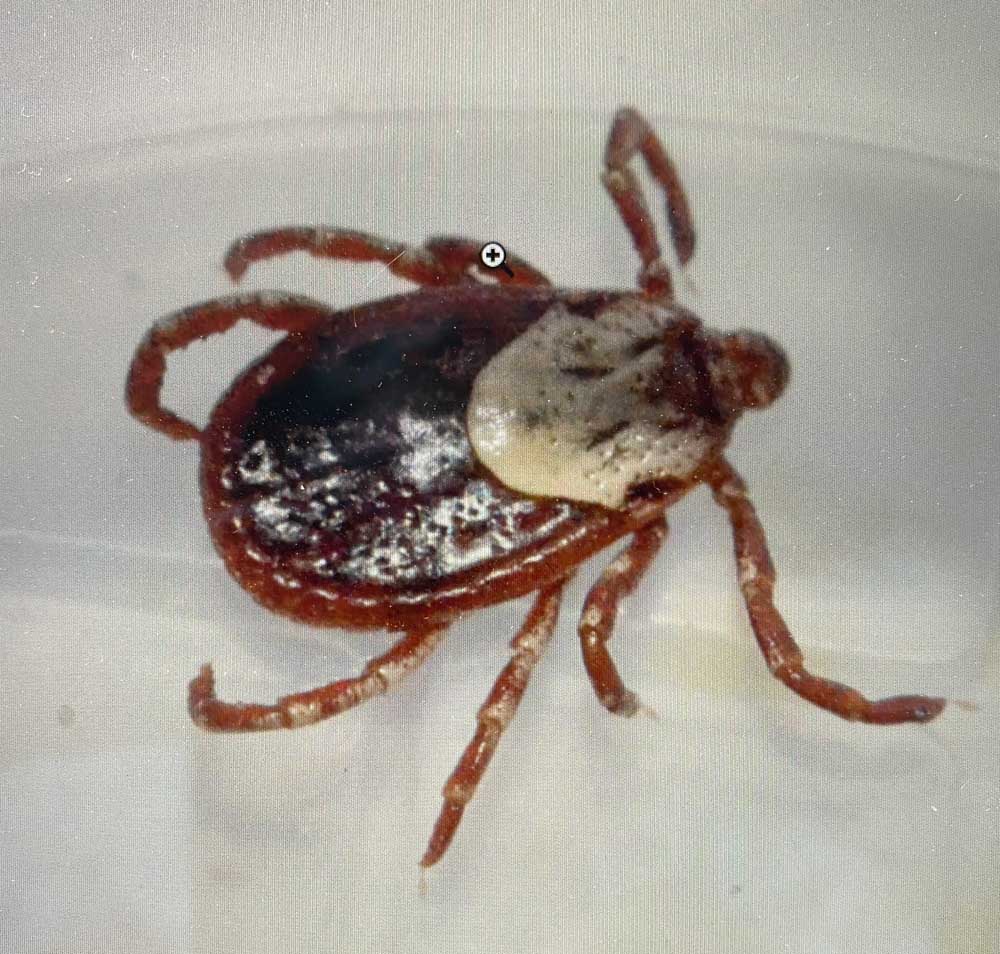Coast Chronicles: Ick — ticks!
Published 12:35 pm Monday, May 27, 2024

- While bird watching at Fort Steven, Mike Patterson found this tick on himself and documented it with a photo and location tag on i-Naturalist.
Yikes
I’m pretty much of a softie when it comes to the animal, bird, fish, plant or insect kingdoms. If there’s a fly buzzing around in the house in danger of becoming food for my resident spiders, I grab a glass and take him/her outside. But I draw the line at mosquitoes and ticks. If things want to suck my blood, that’s over the top in my book.
Mosquitoes… OK, they make a little poke-hole, suck away, and then are gone, leaving an itchy spot for a couple days. Though we can’t give them a total pass because they can transmit West Nile virus, western equine encephalitis, and St. Louis encephalitis. Still, IMHO, ticks are the real vampires. They bury their heads into your flesh and hang on for hours.
As kids of eight or nine ranging around Rimrock Lake just off the White Pass Highway in Eastern Washington, my sis and I went out gathering pine cones one morning and when we returned we had to be completely disrobed and “de-ticked” of many creepy black bugs, some attached, some just wandering around our young bodies. This incident in our early years left an indelibly terrifying impression on both of us.
That was a scene I hadn’t thought about until last year while spending an otherwise lovely weekend at the Gualala, California ranch of a good friend; I woke in the morning with a tick sucking away on my arm. And then, two days later after traveling to another state, I found a tick installed on Jackson’s belly. My revulsion was palpable. I have crossed that — however lovely coastal property — off my visiting list forever. (Also now because — oh, by the way — the highway is falling into the ocean.)
American dog ticks
So when a couple weeks ago I casually brushed something off of my neck, I was horrified to find that it was a big black tick. Two days later, another smaller one was also crawling on me. What is going on? I never remember having ticks on the Peninsula before.
So I emailed my bio-go-to-guru Kathleen Sayce with a question, “This is the first year I have ever seen ticks on the Peninsula, and now I’ve had two people call me asking about this. Have we always had ticks and just not noticed them? Are there more now because of the changes in the weather? I think the deer bring them, but please tell me what you know.”
‘This is the first year I have ever seen ticks on the Peninsula, and now I’ve had two people call me asking about this. Have we always had ticks and just not noticed them? Are there more now because of the changes in the weather?’
Her response: “American dog ticks are more common here, due to longer, drier, warmer summers. These ticks are known carriers of Rocky Mountain spotted fever. All mammals can carry them around, from mice and voles up to elk, bear and deer. Mike Patterson picked one up at Fort Stevens last week and posted a photo on i-Naturalist. There may be other tick species here now too. We used to think that this was a dry side of the Cascades issue, but now it’s an everywhere issue.”
Ticks prey on any warm-blooded mammal and we pick them up while walking or hiking through high grass or woodlands. They can’t jump — they just cling onto clothing (or fur) and then crawl up and onto you. The New York Times “wirecutter” experts recommend Sawyer Permethrin Premium Insect Repellent for your clothing and gear (not skin!). “It kills insects instead of just shooing them away.”
Sightings and documentation
If you are so inclined, there is a way to document your own personal tick find. Kathleen notes, “i-Naturalist is an online database of biotic observations, hosted by California Academy of Sciences. To access it you set up a free account, which gives you search privileges. www.inaturalist.org.” (If you want more pics of these gruesome bugs and where they’ve been sighted: tinyurl.com/vsve5sb. But don’t blame me when you start itching all over…)
As mentioned, I got a couple calls last week, one from Michael Carmel who wanted to tell me about “Ticks! I talked to the Wiegardts and Todd mentioned that they’ve been taking ticks off their dogs and I thought this might make a good story.”
I gave Todd a quick call. “Yes,” he said, “I’ve been seeing ticks. As a kid I remember them here, fleas too. But I hadn’t really noticed them again until this year. Then I started picking ticks off our dog and finally I took him in to the vet for a wellness check, and I found two more on him while we were there! You can use essential oils — peppermint or rosemary — I usually want to avoid the medicines, but you miss one day and you’ve got them again. So I put him on tick medicine this year.”
I also texted Rachel Gana, a master gardener who’s got her finger on the pulse. She wrote me back, “Tick populations increase when the winters are mild and thrive in wet humid conditions. They remain active until temperatures drop down to 40 and they increase when deer and mice populations increase.”
When I asked Michael Carmel if he had a picture of the tick he found he said, “Sorry — I froze it for 24 hours in a plastic pill bottle to kill it, per instructions, filled out the paperwork, wrapped it up for shipment to the Department of Health as Specimen #126 and — and misplaced it! FYI, even individual offices of DFW and DOH seem unaware of the specimen collection program. You can Google it as WA Dept of Health Tick Program.” If you find a tick and you’re up to sending it in to the database, good work. (The submission link and instructions are here: tinyurl.com/2rtandjy).
Kathleen explains a bit more about the documentation aspect of tick-sightings. “This is basically a MMORPG for biology geeks; in many ways it is like e-Bird, a similar but not identical online database for bird sightings. If you find a tick, get a good closeup photo of it, send it to me and I can upload it for you — then the tick taxonomists will look at it and decide if they agree on what it is. Right now if you look at the map, it’s south of the Columbia River in NW Oregon, and not in SW WA — but we all know ticks are here, so photos from people who see them, find them on their bodies, etc., will help detail the actual location of ticks in close to real time. And here’s the link to Mike Patterson’s tick sighting (found on his body) after birding at Fort Stevens State Park. tinyurl.com/5f89mfdx.
Tick removal
So this is just to say, we have ticks on the Peninsula. They are nothing to mess with. According to the Washington State Department of Health, ticks in our state can transmit anaplasmosis, babesiosis, ehrlichiosis, Lyme disease, Rocky Mountain spotted fever, tick-borne relapsing fever, tick paralysis, tularemia.
If a tick has already started sucking on you or your dog, find a pair of fine-tipped tweezers, grab that bloodsucker as close to the skin as possible, and pull with steady pressure. (Don’t use lighter fluid or put a match close to it — these are useless myths about tick removal.) A friend also recommends the JOTOVO tick remover: a little device you can attach to a key ring. You want to get the head out if you can. If not, don’t mess with it. Just clean the spot with rubbing alcohol or soap and water and let it heal.
For enough tick information to keep you up at night: tinyurl.com/mvmszb7f. Here ends the public service announcements about icky ticks.








